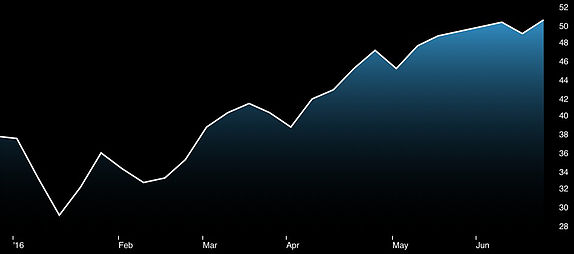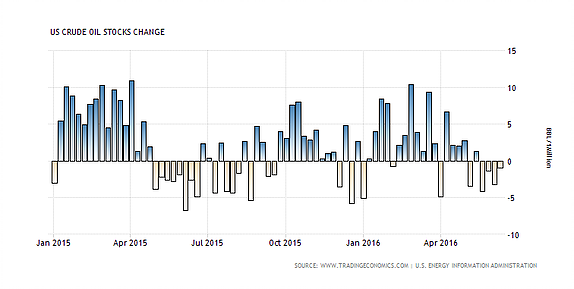The rally in oil prices appears to be stronger than what many analysts have expected. In the past few months, many negative events have taken place around the world. Starting with the failure of oil producers to reach an output freeze deal during Doha’s meeting, the continuous growth of Iran’s oil output and OPEC’s in general, and most recently the concerns over the Brexit.
These events have imposed a huge threat to the rally in oil prices. In fact, during each event, we saw many oil market analysts doubting the rally in oil prices and expecting it to reverse a course. However, the actual impact of such negative events have been limited in terms of the duration and the oil price volatility caused. Throughout these events, the oil prices rally has shown a huge resistance and continued its upward path.

Oil Price Rally Since February: Brent Crude Oil Price
The recent oil prices recovery after oil prices retreated in mid-June as the rising likelihood of a Brexit raised concerns about the economic fallout in Europe is a simple example of such a fact. Oil prices fell sharply below $50/bbl aimed worries over a possible Brexit from the EU. The fall in oil prices didn’t last long. Oil prices recovered to levels above $50 a barrel despite the huge volatility caused by such an event.
What is next for oil prices?
Given the current positive market sentiments along with other positive news coming from around the world, oil prices will not stay at $50 a barrel for quite long. In fact, in the coming weeks, oil prices could head above $55 a barrel reaching to $60/bbl, and here is why.
1- Unchanged Interest Rate and Weaker U.S. Dollar
On Wednesday last week, the U.S. Federal Reserve decided to keep interest rates unchanged. The decision came as no surprise, especially after the brutal jobs report of May. Keeping interest rates unchanged means a weaker U.S. dollar. Given the inverse relationship between the greenback and oil prices, weakness in U.S. dollar is directly translated into strength in oil prices.
The Fed has also cut its economic growth forecast by 0.1 percentage point to 2 percent this year. With the Fed expecting a slower economic growth, interest rate hike is questionable. It will take a while until the Fed makes sure there are signs of economy strength. Till then, keeping interest rate unchanged will support the rally in oil prices.
2- Expected Oil Outages
Oil outages in many countries such as Canada, Nigeria, and Libya have increasingly contributed to the rally in oil prices over the past few months up until today. According to the IEA, outages from OPEC and non-OPEC countries cut global oil supply by nearly 0.8 mb/d in May. Although Canada’s shut-in production will be fully restored in the near future, outages in both Nigeria and Libya appear to be escalating.
In Nigeria, militants attacks on oil and gas infrastructures have decreased the country’s oil production to thirty-year lows. While government official say they have reached to a one-month ceasefire agreement with the rebels in the Niger Delta, what goes on the ground proves opposite. In fact, yesterday, the Niger Delta rebels denied having any ceasefire agreement with the Nigerian government. This news tell us one thing; militants attacks on oil and gas facilities will intensify in coming weeks.
Adding to the existing troubles the country is going through, the Nigerian oil workers threaten to go on strike over what they call it as an engagement of some companies in anti-labor practices. The oil workers have given these companies seven days starting on Monday, June 20, to change what the workers believe to be anti-labor practices. If the workers go on strike, the oil and gas industry activities will shutdown completely resulting in more oil outages.
Libya on the other hand is not in a better place than Nigeria despite occasional signs of optimism. The country’s oil and gas fields and facilities are also under attacks from different militia groups. With the troubles the country is going through, it appears that Libya has a long way to go before making a significant increase to its oil production. For Libya, expectations are only for the worst to come.
3- U.S. Crude Inventory Drawdowns
The summer session is officially here. That means the seasonal U.S. inventory drawdowns is here as well. According to the EIA, the current session started with crude oil inventories at 531.5 million barrels as of 10 June. Crude inventory has declined for 3 consecutive weeks since then.
Inventory drawdowns are expected to increase from July to September as gasoline demand increases during the U.S. summer season. According to a report by Deutsche Bank, the rate of weekly drawdown should increase from the beginning of July and accelerate further into August.

US Crude Oil Stocks Changes
The report expects the US crude oil inventory drawdown to average at a weekly rate of -2.88 mmbbl/week. This would reduce the crude oil inventory surplus from 152 mmbbl (above the 2010-14 average) currently to 135 mmbbl at the beginning of September.
The expected declines in U.S. crude oil inventory in the coming weeks will definitely support crude oil prices and give the rally more momentum. In fact, in the coming weeks, the main variable that will have a huge impact on oil prices will be the crude oil inventory data.
4- U.S. Crude Oil Production Declines
U.S. crude oil production has been in a steady and continuous decline since the beginning of 2016. According to EIA, from January to June, 2016, U.S. crude oil production declined around 500,000 barrel/day from 9.2 million barrel/day in January. The continuous declines in U.S. oil production have supported the rally in oil prices throughout the past months. It has given traders a sign that, despite the slow supply declines, the oil market is moving toward a more balance. And that fueled optimism in the oil market.
U.S. crude oil production is expected to continue its decline in the coming few months. These declines will support the crude oil prices. Although few analysts believe the recent uptick in U.S. rig count will cap oil prices, its impact will not be prompt. With oil prices hovering around $50 a barrel, few U.S. crude oil producers have started drilling activities, and could soon start to activate drilled but uncompleted wells. That is true, but we have to understand a very important point.
Drilling new wells or moving some of those DUCs into the production phase takes time. In the best case, it would take at least three months before new output comes online. There is a generally a lag between a price signal and production impact of about 4 to 7 months according to Genscape. In the meantime, we will still hear news of increasing rig counts. However, its impact on oil prices and the declines of U.S. crude oil production will be meaningless.
The current oil market state is characterized by a high level of optimism and a feeling that the worse is over. Many investments banks such as Goldman Sachs have made positive changes to their oil market outlooks for oil prices in the second half of 2016. And just recently, the IEA published its oil market report in which they expect the oil market to be balanced in the second half of 2016. The IEA increased its forecast for oil demand growth to in 2016 from 1.2 million barrel/day to 1.3 million barrel/day as a result of higher than expected growth in oil demand in the 1Q2016.
Given the current positive oil market outlook for the second half of 2016, and taking into account the above four factors; weaker U.S. dollar, augmented outages, drawdowns in U.S. crude inventory and declines in its oil production, oil prices are set to go higher in the coming weeks. Unless a negative and unexpected negative event takes place, oil prices will be above $55/bbl heading to $60/bbl in a few weeks.

